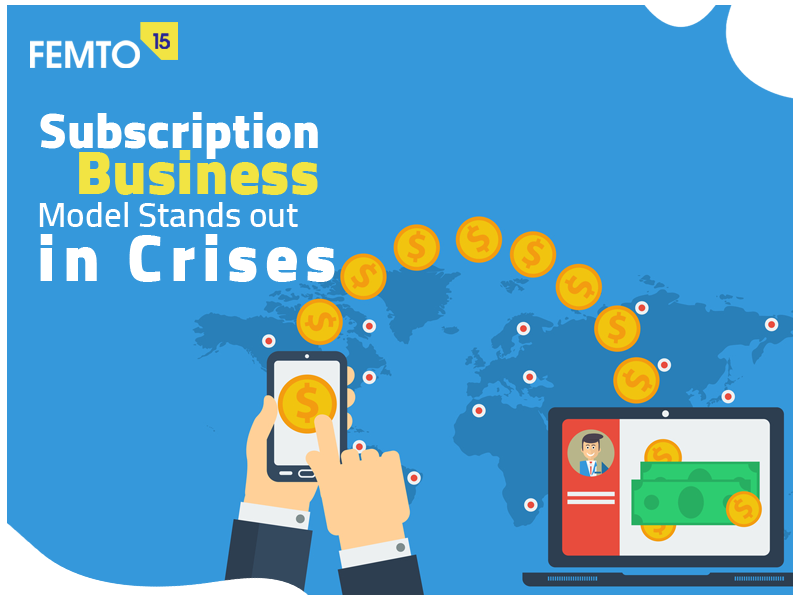
Subscription Business Model Stands out in Crises
By Eman Azzoz - June 11, 2020A business model that stands out in crises, that doesn’t get highly affected by outer disasters, and that keeps growing while other business sectors may be shutting down, is a dream of any entrepreneur.
Lately, another economic collapse drowns the world due to COVID-19, leaving lots of businesses at a high risk of trying to manage things out. Meanwhile, the subscription business model stands out proving that it’s there to stay and guide the world ahead.
In this article, we cover two main matters about this model:
- A broad definition of the subscription model
- Subscription model attributes
A broad definition of the subscription model
The main idea of a subscription model is that you have an ongoing business with customers. The deal doesn't end by a contract and a goodbye, rather it’s a periodic process where you offer a service or a product for a specific revenue paid periodically (each weak, month, season, year, etc).
So, what’s the big difference?
At a traditional model, you give the customer the product/service, they pay for it, they own it, they may or may not come back again, and they may call later (or you call) for maintenance or for trying to make more deals.
In the subscription model, you have a relationship with customers, they won’t go away unless their demand or cash ends, or you stop providing value.
When can customers leave you?
No commitments, they can leave whenever they want. If they feel they don’t get value, they will unsubscribe, they won’t simply pay for the next period.
That’s why, you should always look for satisfying them and ensuring they are active, happy, and achieving their goals (which we call customer success). The subscription model has a lot to do with customer loyalty, customer lifetime value, and customer retention.
Subscription model attributes
Let’s try to illustrate some attributes of this model:
As long as there is a need, there is revenue
When the world falls up, if your service or product is still needed you will stand out, you maybe even at the top of the growth (just like Zoom :) ).
This model means you know that the same customers will keep needing your product or service.
Long time relationship with customers
It’s not a one-time relationship. You may take time to convince customers to subscribe, but once they do, you work on making them stick for as long as you can.
Do you hear that “As long as you can” term?
It means you already have a bond with them, which can last as long as they have a demand that you can fulfill.
Lower risk
It provides much lower risk on the customer’s side, they can taste first, if they like it, they stick, and they can leave whenever they want. No commitments!
Nowadays, people prefer to get what they need when they need it and leave it when they don’t.
People can afford your product/service
Your service or product is really valuable, but not many people can afford its cost?
A minimum budget to get what you want is a great idea for those who can’t pay. It’s much cheaper for a customer to pay a little fee for a service or product and have the access to use it when needed than paying thousands of dollars to have it (forever).
A great example of that is gym equipment, as lots of people can't afford to buy it.
Stability
You know when will they pay, you track the active/inactive guys, and you can predict churn according to their previous behavior. You can even track (on the digital world) how they use your service, for what reasons, for how long, etc.
All this data shows you the way and helps you stand steady in various situations (including crisis).
Predictable
“No one knows what the future holds”
In the business world, we plan, we track, we analyze, and we try to figure out where are we going, which is much easier in the subscription model.
You interact with users periodically, they keep asking, you keep answering, you know how you influence them, and what may make them stop paying.
Loyal customers make you money
One of the main advantages of the subscription model is that it fuels itself with time. If you focus on creating loyal customers, you minimize CAC and churn. You have a customer base that widens itself.
Final words
Lots of companies and industries are going for the subscription model as an alternative to the traditional model, just like Adobe and Microsoft. These days those subscription guys, like Netflix and Zoom, are growing while everybody is freaking out.
Subscription business may not be the only model that handles the situation, but we claim it works better and easier for software industries, which is our next topic.
ABOUT AUTHOR
Eman Azzoz


you may also like
0 comments